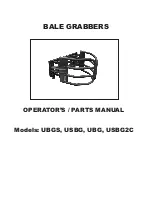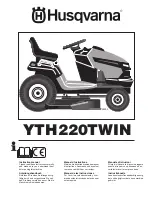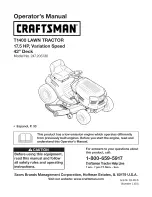
3.1 Adjusting the rear wheels
This section describe the procedure to change the
width of the rear tread.
WARNING
To avoid personal injury or death:
• Before jacking up the tractor, park it on a firm
and level ground and chock the rear wheels.
• Fix the front axle to keep it from pivoting.
• Select the jacks that withstand the machine
weight and set them up as shown in the
following figure.
(1) Jack point
1. Remove the bolts which mount the wheel rim and /
or disk.
2. Change the position of the rim and / or disk (right
and left) to the desired position.
3. Tighten the bolts.
IMPORTANT :
• Always attach the tires as shown in the
following figure.
• If you do not attach the rear wheel as the
following figure, transmission parts may be
damaged.
• Do not turn the rear discs to obtain the wider
tread.
• When re-fitting or adjusting a wheel, tighten
the bolts to the following torques.
(1) Bolt
Bolt (1)
Tightening torque
196.0 N
⋅
m to 225.0 N
⋅
m
(20.0 kgf
⋅
m to 23.0 kgf
⋅
m)
[144.6 ft
⋅
lbs to 166.0 ft
⋅
lbs]
Then recheck after driving the tractor as
follows, and thereafter according to
SERVICE INTERVALS on page 91.
Driving tractor
200 m (200 yards) and 10 times of shuttle
movement by 5 m (5 yards)
BALLAST
WARNING
To avoid personal injury or death:
• You will need the additional ballast for
transporting the heavy implements. When the
implement is raised, drive slowly over rough
ground, regardless of how much ballast is used.
• Do not fill the front wheels with liquid to
maintain steering control.
1. Front ballast
Add weights if needed for stability (2WD and 4WD
models) and improve traction (4WD model). Heavy
pulling and heavy rear mounted implements tend to lift
the front wheels.
Add enough ballast to maintain the steering control and
prevent tip over.
Remove the weight when no longer needed.
IMPORTANT :
• Do not overload the tires.
• Add no more weight than indicated in the
following table.
Maximum weight
25 kg×7 pieces
(386 lbs.)
TIRES, WHEELS, AND BALLAST
WHEEL ADJUSTMENT
88
L4701
Summary of Contents for L4701
Page 10: ...6 L4701...
Page 18: ...SAFETY LABELS SAFE OPERATION 14 L4701...
Page 19: ...SAFE OPERATION L4701 15...
Page 20: ...SAFE OPERATION 16 L4701...
Page 21: ...SAFE OPERATION L4701 17...











































